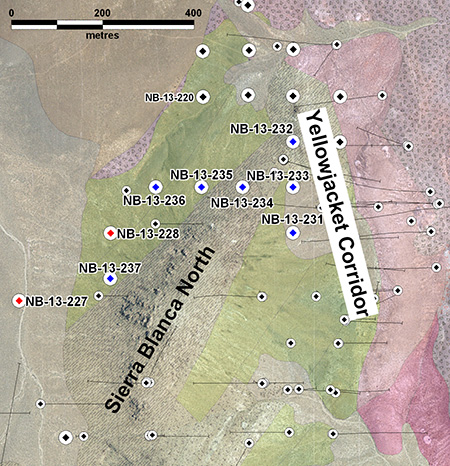Corvus Gold Step-out Drilling Extends Gold Mineralization West of Sierra Blanca Deposit Identifying New Covered Target
Highlights: NB-13-227 – 38 metres @ 0.47g/t Gold from 17m
Vancouver, B.C……Corvus Gold Inc. (“Corvus” or the “Company”) – (TSX: KOR, OTCQX: CORVF) announces results from two additional reverse circulation (RC) holes from the ongoing 2013 drill program where drilling to date has concentrated predominantly at the Yellowjacket Zone and North Sierra Blanca. The latest holes were stepout holes drilled to explore the western extent of the Sierra Blanca Deposit (Figure 1). Hole NB-13-227 collared in alluvial cover more than 100 metres to the west of the currently known Sierra Blanca deposit and encountered 38 metres of 0.5 g/t gold starting at 17 metres in depth, immediately below gravel cover (Table 1). Mineralization under the pediment is associated with carbonate veining in several discrete structures, similar to the Mayflower mineralization to the south.
Shallow oxide mineralization with grades higher than the average Sierra Blanca grade (outlined in the most recent PEA; NR-13-13, June 4, 2013) is a highly attractive early mining target. This intersection, which is the first test of the western pediment, opens the door to a significant expansion of the deposit to the west. The mineralization is hosted by dacitic volcanic units which have been a poor host in other areas and suggests close proximity to a strong mineralizing system.
NB-13-228 was also drilled on the western flank of Sierra Blanca and encountered 93 metres of 0.2 g/t gold which is typical for this part of Sierra Blanca system. However, in addition to the normal disseminated, low-grade, style mineralization, a zone 6 metre thick with 7.6 g/t silver was discovered in a discrete structure outside of the main deposit (Table 1).
The high silver to gold ratio of 250 to 1 in this new structure zone could be an early indication of another Yellowjacket type high-grade system is operating on the west flank of Sierra Blanca. Similar silver-rich mineralization was also found in hole NB-13-220 (reported July 10, 2013, NR-13-16) along a structure to the north of NB-13-228 (Figure 1). This new highly attractive structural target will be followed up with core drilling in the future.
Table 1: Significant intercepts* from North Sierra Blanca RC holes.
| HoleID | From (m) | To (m) | Interval (m) | Gold (g/t) | Silver (g/t) | Comments |
|
|
||||||
| NB-13-227 | 16.8 | 54.9 | 38.1 | 0.47 | 0.71 | In Dacite |
| 61.0 | 68.6 | 7.6 | 0.38 | 0.71 | In Dacite | |
|
|
||||||
| NB-13-228 | 121.9 | 128.0 | 6.1 | 0.03 | 7.63 | High silver zone |
| 140.2 | 233.2 | 93.0 | 0.17 | 0.46 | ||
|
|
||||||
*Intercepts calculated with 0.1g/t cutoff and up to 3m internal waste. Assuming that the mineralization is
roughly stratiform in character the intercepts are approximately true thickness. All holes are vertical.
Jeff Pontius, Chief Executive Officer, states: “North Bullfrog continues to surprise us with new zones and styles of mineralization everywhere we have drilled to date indicating an extensive, District scale gold-silver system. Both of these new holes represent early indications of what might develop into significant new discovery potential which could have a dramatic impact not only on near-term mine development but on the longer-term project potential and shareholder value.”

Figure 1: Location of new reverse circulation at West Sierra Blanca. Red collars indicate assays reported in Table 1. Blue collars are RC holes that have been drilled but have assays pending.
North Sierra Blanca Target
The objective of the 2013 reverse circulation drill program at North Sierra Blanca is to map the distribution of higher grade, disseminated mineralization for the enhancement and optimization of the overall North Bullfrog mine plan by defining and expanding new higher grade zones in the greater system. Discoveries made to date with this exploration program have not only defined new large areas of higher grade disseminated mineralization but have outlined a number of areas with potential for the discovery of other Yellowjacket type, high-grade, structural zones. The current 100 metre grid spacing has not only provided data for resource expansion but critical information on the stratigraphy and alteration to link with our detailed geophysical data to more accurately outline potential high-grade structures for follow-up drill testing. The mineralization in NB-13-227 represents an important new area with early mining starter pit potential.
About the North Bullfrog Project, Nevada
Corvus controls 100% of its North Bullfrog Project, which covers approximately 70 km² in southern Nevada just north of the historic Bullfrog gold mine formerly operated by Barrick Gold Corporation. The property package is made up of a number of leased patented federal mining claims and 758 federal unpatented mining claims. The project has excellent infrastructure, being adjacent to a major highway and power corridor. The Company’s independent consultants completed a robust positive Preliminary Economic Assessment on the existing resource in June 2013.
The project currently includes numerous prospective gold targets with four (Mayflower, Sierra Blanca, Jolly Jane and Connection) containing an estimated oxidized Indicated Resource of 36.7 Mt at an average grade of 0.26 g/t gold for 308,000 ounces of gold and an oxidized Inferred Resource of 220.4 Mt at 0.18 g/t gold for 1,289,000 ounces of gold (both at a 0.1 g/t gold cutoff), with appreciable silver credits. Unoxidized Inferred mineral resources are 221.6 Mt at 0.19 g/t for 1,361,000 ounces of gold (at a 0.1 g/t gold cutoff).
Mineralization occurs in two primary forms: (1) broad stratabound bulk-tonnage gold zones such as the Sierra Blanca and Jolly Jane systems; and (2) moderately thick zones of high-grade gold and silver mineralization hosted by structural zones with breccias and quartz-sulphide vein stockworks such as the Mayflower and Yellowjacket targets. The Company is actively pursuing both types of mineralization.
A video of the North Bullfrog project showing location, infrastructure access and 2010 winter drilling is available on the Company’s website athttp://www.corvusgold.com/
Qualified Person and Quality Control/Quality Assurance
Jeffrey A. Pontius (CPG 11044), a qualified person as defined by National Instrument 43-101, has supervised the preparation of the scientific and technical information (other than the resource estimate) that form the basis for this news release and has approved the disclosure herein. Mr. Pontius is not independent of Corvus, as he is the CEO and holds common shares and incentive stock options.
Mr. Gary Giroux, M.Sc., P. Eng (B.C.), a consulting geological engineer employed by Giroux Consultants Ltd., has acted as the Qualified Person, as defined in NI 43-101, for the Giroux Consultants Ltd. mineral resource estimate. He has over 30 years of experience in all stages of mineral exploration, development and production. Mr. Giroux specializes in computer applications in ore reserve estimation, and has consulted both nationally and internationally in this field. He has authored many papers on geostatistics and ore reserve estimation and has practiced as a Geological Engineer since 1970 and provided geostatistical services to the industry since 1976. Both Mr. Giroux and Giroux Consultants Ltd. are independent of the Company under NI 43-101.
The work program at North Bullfrog was designed and supervised by Russell Myers (CPG 11433), President of Corvus, and Mark Reischman, Corvus Nevada Exploration Manager, who are responsible for all aspects of the work, including the quality control/quality assurance program. On-site personnel at the project log and track all samples prior to sealing and shipping. Quality control is monitored by the insertion of blind certified standard reference materials and blanks into each sample shipment. All resource sample shipments are sealed and shipped to ALS Chemex in Reno, Nevada, for preparation and then on to ALS Chemex in Reno, Nevada, or Vancouver, B.C., for assaying. ALS Chemex’s quality system complies with the requirements for the International Standards ISO 9001:2000 and ISO 17025:1999. Analytical accuracy and precision are monitored by the analysis of reagent blanks, reference material and replicate samples. Finally, representative blind duplicate samples are forwarded to ALS Chemex and an ISO compliant third party laboratory for additional quality control. McClelland Laboratories Inc. prepared composites from duplicated RC sample splits collected during drilling. Bulk samples were sealed on site and delivered to McClelland Laboratories Inc. by ALS Chemex or Corvus personnel. All metallurgical testing reported here was conducted or managed by McClelland Laboratories Inc.
About Corvus Gold Inc.
Corvus Gold Inc. is a resource exploration company, focused in Nevada, Alaska and Quebec, which controls a number of exploration projects representing a spectrum of early-stage to advanced gold projects. Corvus is focused on advancing its 100% owned Nevada, North Bullfrog project towards a potential development decision and continuing to explore for new major gold discoveries. Corvus is committed to building shareholder value through new discoveries and leveraging noncore assets via partner funded exploration work into carried and or royalty interests that provide shareholders with exposure to gold production.
On behalf of
Corvus Gold Inc.
(signed) Jeffrey A. Pontius
Jeffrey A. Pontius,
Chairman and Chief Executive Officer
Contact Information: Ryan Ko
Investor Relations
Email: info@corvusgold.com
Phone: 1-888-770-7488 (toll free) or (604) 638-3246 / Fax: (604) 408-7499
Cautionary Note Regarding Forward-Looking Statements
This press release contains forward-looking statements and forward-looking information (collectively, “forward-looking statements”) within the meaning of applicable Canadian and US securities legislation. All statements, other than statements of historical fact, included herein including, without limitation, statements regarding the anticipated content, commencement and cost of exploration programs, anticipated exploration program results, the discovery and delineation of mineral deposits/resources/reserves, the potential for any mining or production at North Bullfrog, the potential for the identification of multiple deposits at North Bullfrog, the potential for a low-cost run-of-mine heap leach operation at North Bullfrog, the potential for there to be a low strip ratio in connection with any mine at North Bullfrog, the potential for the existence or location of additional high-grade veins, the proposed completion of a PEA for the North Bullfrog project, the potential for additional resources to be located between certain of the existing deposits, the potential for the Company to secure or receive any royalties in the future, business and financing plans and business trends, are forward-looking statements. Although the Company believes that such statements are reasonable, it can give no assurance that such expectations will prove to be correct. Forward-looking statements are typically identified by words such as: believe, expect, anticipate, intend, estimate, postulate and similar expressions, or are those, which, by their nature, refer to future events. The Company cautions investors that any forward-looking statements by the Company are not guarantees of future results or performance, and that actual results may differ materially from those in forward looking statements as a result of various factors, including, but not limited to, variations in the nature, quality and quantity of any mineral deposits that may be located,variations in the market price of any mineral products the Company may produce or plan to produce, the Company’s inability to obtain any necessary permits, consents or authorizations required for its activities, the Company’s inability to produce minerals from its properties successfully or profitably, to continue its projected growth, to raise the necessary capital or to be fully able to implement its business strategies, and other risks and uncertainties disclosed in the Company’s latest interim Management Discussion and Analysis and filed with certain securities commissions in Canada. All of the Company’s Canadian public disclosure filings may be accessed via www.sedar.com and readers are urged to review these materials, including the technical reports filed with respect to the Company’s mineral properties.
Cautionary Note Regarding References to Resources and Reserves
National Instrument 43 101 – Standards of Disclosure for Mineral Projects (“NI 43-101”) is a rule developed by the Canadian Securities Administrators which establishes standards for all public disclosure an issuer makes of scientific and technical information concerning mineral projects. Unless otherwise indicated, all resource estimates contained in or incorporated by reference in this press release have been prepared in accordance with NI 43-101 and the guidelines set out in the Canadian Institute of Mining, Metallurgy and Petroleum (the “CIM”) Standards on Mineral Resource and Mineral Reserves, adopted by the CIM Council on November 14, 2004 (the “CIM Standards”) as they may be amended from time to time by the CIM.
United States shareholders are cautioned that the requirements and terminology of NI 43-101 and the CIM Standards differ significantly from the requirements and terminology of the SEC set forth in the SEC’s Industry Guide 7 (“SEC Industry Guide 7”). Accordingly, the Company’s disclosures regarding mineralization may not be comparable to similar information disclosed by companies subject to SEC Industry Guide 7. Without limiting the foregoing, while the terms “mineral resources”, “inferred mineral resources”, “indicated mineral resources” and “measured mineral resources” are recognized and required by NI 43-101 and the CIM Standards, they are not recognized by the SEC and are not permitted to be used in documents filed with the SEC by companies subject to SEC Industry Guide 7. Mineral resources which are not mineral reserves do not have demonstrated economic viability, and US investors are cautioned not to assume that all or any part of a mineral resource will ever be converted into reserves. Further, inferred resources have a great amount of uncertainty as to their existence and as to whether they can be mined legally or economically. It cannot be assumed that all or any part of the inferred resources will ever be upgraded to a higher resource category. Under Canadian rules, estimates of inferred mineral resources may not form the basis of a feasibility study or prefeasibility study, except in rare cases. The SEC normally only permits issuers to report mineralization that does not constitute SEC Industry Guide 7 compliant “reserves” as in-place tonnage and grade without reference to unit amounts. The term “contained ounces” is not permitted under the rules of SEC Industry Guide 7. In addition, the NI 43-101 and CIM Standards definition of a “reserve” differs from the definition in SEC Industry Guide 7. In SEC Industry Guide 7, a mineral reserve is defined as a part of a mineral deposit which could be economically and legally extracted or produced at the time the mineral reserve determination is made, and a “final” or “bankable” feasibility study is required to report reserves, the three-year historical price is used in any reserve or cash flow analysis of designated reserves and the primary environmental analysis or report must be filed with the appropriate governmental authority.
Caution Regarding Adjacent or Similar Mineral Properties
This news release contains information with respect to adjacent or similar mineral properties in respect of which the Company has no interest or rights to explore or mine. The Company advises US investors that the mining guidelines of the US Securities and Exchange Commission (the “SEC”) set forth in the SEC’s Industry Guide 7 (“SEC Industry Guide 7”) strictly prohibit information of this type in documents filed with the SEC. Readers are cautioned that the Company has no interest in or right to acquire any interest in any such properties, and that mineral deposits on adjacent or similar properties are not indicative of mineral deposits on the Company’s properties
This press release is not, and is not to be construed in any way as, an offer to buy or sell securities in the United States.






